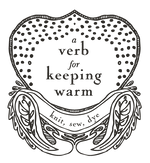
Some of the hardest colors to photograph are naturally dyed greens made of yellow and grey. In person, these grey greens shift with the light, which one of their attributes which makes them so charming. Though when trying to convey their beauty and nuances over the internet, it can pose quite a challenge.
We make these greens with plants that provide yellow such as fustic, osage, or weld and then we add a bit of logwood purple. Each yellow has a slightly different shade; some more yellow-green, some more golden. This shade of yellow and the concentration of yellow, combines with the amount of logwood purple affects the color. As learned from last week's blog entry about the process of creating a blue, green, and brown colorway named Mermaid, when this dye is first applied to the skein, it looks either yellow or brown, not green. With heat, the color develops, and the shade of green comes forth.
Green colorways we make which use the combination of yellow and grey include, from lightest to darkest, The French Monk's Finest, Jade, and Cypress. As many of you know who have tried to order the famous French Monk's Finest, that chartreuse color is in particular hard to create because more times than not there is just a smidge too much logwood which sends it into the realm of Jade. Of course, we don't find this out until the yarn has heated, thus setting the color, making it too late to shift it back to the more yellow side of the spectrum.
Now one could ask, well why don't you measure more carefully? Right? Well, I wish it were that simple. Both the fustic and osage we use are in liquid form. In the case of fustic, the liquid sometimes separates ever so slightly. It's not visible to the eye. But can be felt by the texture of the water when stirring. So while I try to be extra careful, it is inevitable that the yellow on Pot 1 is more concentrated than on Pot 2. And all the dyes concentration shifts from time to time due to nature. We may have been using just a pinch of logwood and were able to get the right green. Though wait a few months, get a new shipment, and that pinch may be overkill. And once again we find ourselves with a large beautiful batch of Jade.
This week, in order to try and get French Monk, I added the clear bright yellow dye, weld. I first dyed, the batch on the right, too much logwood, so now we have a new color called Highbrow for short (the long name is Not Quite French Monk but still Highbrow). Having learned from our mistake backing off the logwood, and increasing the weld, on the left, we achieved French Monk. Voila!
While I enjoy the challenge of working with natural dyes and establishing reproducibility, I hope in the next year to have more yarn dyed with the label Limited Edition. These are colors which were created by the dash here, an accident there, in which the plants and the yarn really have their own story to tell.
The yarn pictured above our available for sale by calling the shop. They will also be with us at the upcoming yarn show, Stitches West, in Santa Clara.
